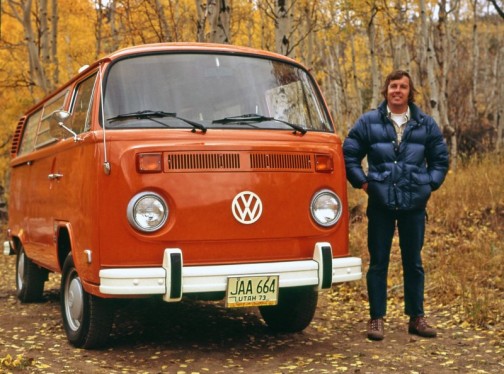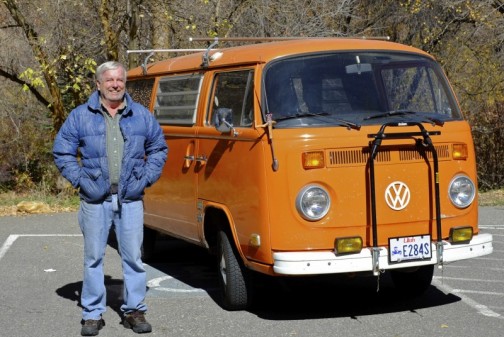Back in 1973, a fully-equipped Volkswagen Campmobile went for $3,900. But I didn’t pay that much for mine—no, I followed my father’s advice and “dickered” with the salesman.
“I see that the sticker price is $3,900,” I said to Heinz. “But what’s the REAL price?”
“The real price is $3,900,” answered Heinz. That is, unless you wish to put off buying it until next week, in which case the price will be $4,400.
One week later I returned to Volkswagen Intermountain and bought the car—for $4,400. In deference to my superior dickering skills, Heinz threw in a pair of free bumper guards.
Today those bumper guards are gone, but the rest of the bus looks pretty much the same as it did the day I drove it off the lot in Salt Lake City. Two days later I got my first oil change at a Volkswagen dealership in Boise. By week’s end, I was refilling the tank in Kalispell, Montana. At the time, leaded regular cost thirty-nine cents a gallon.
Over the past 41 years Big Orange and I have gone everywhere together—and by that I mean everywhere in the Mountain West and Great Basin, although for a time in the mid Seventies my bus wore Texas plates. For gas money I collected aluminum beer cans along Bee Cave Road outside Austin, home of Waylon and Willie and the boys. In my rear window is displayed a fighting armadillo decal—an artifact from the birthplace of the SXSW music movement: Armadillo World Headquarters.
There are other artifacts and talismans I don’t leave home without. These include a half dozen stuffed animals, a World War II-era bayonet, salt and pepper shakers from Old Miles, Queensland, an REI insulated thermos and a single-mantle Coleman lantern. Many’s the night that little lantern has kept me company. It makes a sound like the murmuring of a distant cocktail party—a cocktail party attended in part by yipping coyotes.
Something else I recently found, tucked away in the back corner of the rear closet: my down-filled North Face parka. I must have stowed it away after puffy coats went out of fashion, but what do you know? Now they’re BACK in fashion, and so am I!
People often ask, “How do you keep your Volkswagen looking like new?”
One word: wax. Specifically, Turtle brand paste wax. Hand wax your car regularly and you’ll find the paint won’t fade. Bugs and tar won’t stick, and even if your vehicle is shaped like a non-aerodynamic Twinkie, there’ll be less wind resistance.
Another word: oil. I change my engine oil and filter far more often than necessary. Why? Well, because it’s one thing I know how to do. It gets my hands dirty and gives others the impression I know something about engines.
And how is it that after 41 years and a quarter million miles, I haven’t acquired any dents or scratches? The answer, my friends, is defensive parking. I take care not to park close to clunkers—or Buicks. Matter of fact, I try not to park close to anyone. I park far from the handicapped slots, and never downhill from shopping carts. Since Brighton became a haven for snowboarders, I only ski at Alta, lest I return from the slopes to find my rear-view mirrors missing.
Once—well, maybe twice—my beloved bus nearly caught fire. The first time happened back when I smoked and an ash from my cigarette fell onto the seat cushion between my legs and ignited a small crotch fire. That was my cue to give up smoking, which I immediately did; however, I once had a passenger who smoked, and—unbeknownst to me—the idiot flipped his butt out the passenger side window. Said butt was promptly sucked into the starboard air intake and started a fire in a fire in the engine bay. Had I not pulled off the Interstate at Knolls to relieve myself, I wouldn’t have smelled the smoke in time. Had I not needed to relieve myself, the fire would have soon gotten out of hand.
Since that day I’ve always carried a fire extinguisher—just in case. I drive sparingly, in part because the roads are more crowded today than they were back in 1973. Moreover, people are driving faster and more aggressively. It’s as if they all expect to survive a head-on collision—something that I’ve always known I wouldn’t. Seated just in front of the front axle, I’d be the first to arrive at the scene of the accident, and the one who wouldn’t walk away.
So that’s my final piece of advice, if you wish to keep your car—and yourself—alive. Throttle back, and start paying attention to things around you. Because no appointment or errand or vacation destination or text message is more important than just being here now.

